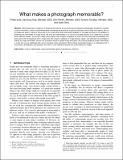| dc.contributor.author | Isola, Phillip John | |
| dc.contributor.author | Xiao, Jianxiong | |
| dc.contributor.author | Parikh, Devi | |
| dc.contributor.author | Torralba, Antonio | |
| dc.contributor.author | Oliva, Aude | |
| dc.date.accessioned | 2014-10-20T14:29:09Z | |
| dc.date.available | 2014-10-20T14:29:09Z | |
| dc.date.issued | 2014-06 | |
| dc.date.submitted | 2013-05 | |
| dc.identifier.issn | 0162-8828 | |
| dc.identifier.issn | 2160-9292 | |
| dc.identifier.uri | http://hdl.handle.net/1721.1/90984 | |
| dc.description.abstract | When glancing at a magazine, or browsing the Internet, we are continuously exposed to photographs. Despite this overflow of visual information, humans are extremely good at remembering thousands of pictures along with some of their visual details. But not all images are equal in memory. Some stick in our minds while others are quickly forgotten. In this paper, we focus on the problem of predicting how memorable an image will be. We show that memorability is an intrinsic and stable property of an image that is shared across different viewers, and remains stable across delays. We introduce a database for which we have measured the probability that each picture will be recognized after a single view. We analyze a collection of image features, labels, and attributes that contribute to making an image memorable, and we train a predictor based on global image descriptors. We find that predicting image memorability is a task that can be addressed with current computer vision techniques. While making memorable images is a challenging task in visualization, photography, and education, this work is a first attempt to quantify this useful property of images. | en_US |
| dc.description.sponsorship | National Science Foundation (U.S.) (Grant 1016862) | en_US |
| dc.description.sponsorship | National Science Foundation (U.S.) (CAREER Award 0747120) | en_US |
| dc.description.sponsorship | United States. Intelligence Advanced Research Projects Activity (Department of the Interior Contract D10PC20023) | en_US |
| dc.description.sponsorship | United States. Office of Naval Research. Multidisciplinary University Research Initiative (N000141010933) | en_US |
| dc.description.sponsorship | Google (Firm) | en_US |
| dc.description.sponsorship | Xerox (Firm) | en_US |
| dc.description.sponsorship | National Science Foundation (U.S.). Graduate Research Fellowship | en_US |
| dc.language.iso | en_US | |
| dc.publisher | Institute of Electrical and Electronics Engineers (IEEE) | en_US |
| dc.relation.isversionof | http://dx.doi.org/10.1109/TPAMI.2013.200 | en_US |
| dc.rights | Creative Commons Attribution-Noncommercial-Share Alike | en_US |
| dc.rights.uri | http://creativecommons.org/licenses/by-nc-sa/4.0/ | en_US |
| dc.source | MIT web domain | en_US |
| dc.title | What Makes a Photograph Memorable? | en_US |
| dc.type | Article | en_US |
| dc.identifier.citation | Isola, Phillip, Jianxiong Xiao, Devi Parikh, Antonio Torralba, and Aude Oliva. “What Makes a Photograph Memorable?” IEEE Trans. Pattern Anal. Mach. Intell. 36, no. 7 (July 2014): 1469–1482. | en_US |
| dc.contributor.department | Massachusetts Institute of Technology. Computer Science and Artificial Intelligence Laboratory | en_US |
| dc.contributor.department | Massachusetts Institute of Technology. Department of Brain and Cognitive Sciences | en_US |
| dc.contributor.department | Massachusetts Institute of Technology. Department of Electrical Engineering and Computer Science | en_US |
| dc.contributor.mitauthor | Isola, Phillip John | en_US |
| dc.contributor.mitauthor | Xiao, Jianxiong | en_US |
| dc.contributor.mitauthor | Torralba, Antonio | en_US |
| dc.contributor.mitauthor | Oliva, Aude | en_US |
| dc.relation.journal | IEEE Transactions on Pattern Analysis and Machine Intelligence | en_US |
| dc.eprint.version | Author's final manuscript | en_US |
| dc.type.uri | http://purl.org/eprint/type/JournalArticle | en_US |
| eprint.status | http://purl.org/eprint/status/PeerReviewed | en_US |
| dspace.orderedauthors | Isola, Phillip; Xiao, Jianxiong; Parikh, Devi; Torralba, Antonio; Oliva, Aude | en_US |
| dc.identifier.orcid | https://orcid.org/0000-0002-1411-6704 | |
| dc.identifier.orcid | https://orcid.org/0000-0003-4915-0256 | |
| mit.license | OPEN_ACCESS_POLICY | en_US |
| mit.metadata.status | Complete | |
